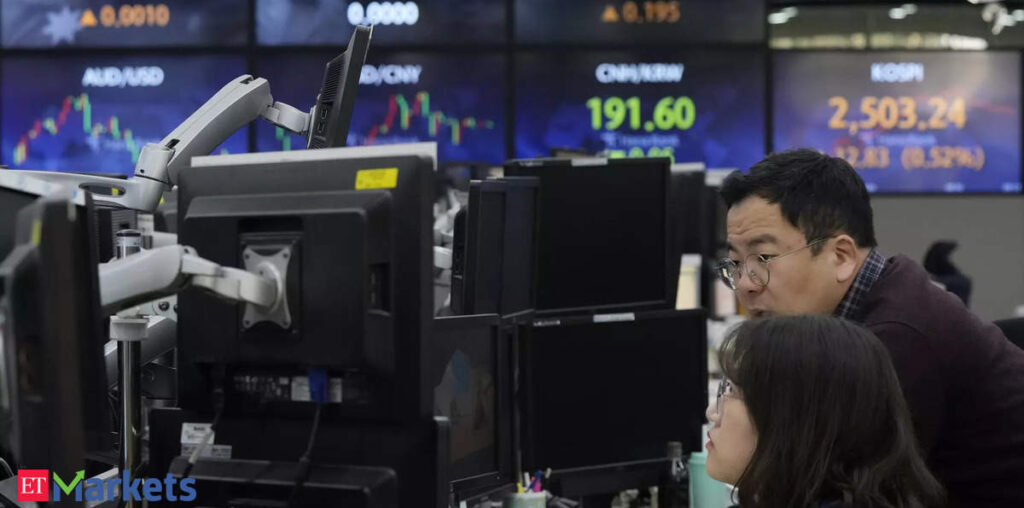Shares in Australia, Japan, and South Korea all fell, while futures for benchmarks in Hong Kong pointed to losses. That’s after equities in the US dropped from nearly overbought levels, following a relentless advance to all-time highs.
US 10-year yields jumped 11 basis points to 4.20% as traders price in a slower pace of monetary policy easing. Federal Reserve Bank of Kansas City President Jeffrey Schmid said he favors a slower pace of interest-rate reductions given uncertainty about how low the US central bank should ultimately cut rates. Australian and New Zealand bonds fell in early trading.
A multitude of factors are driving the bond selloff, including concerns over supply and better US economic data, Chris Weston, head of research at Pepperstone Group Ltd., wrote in a note. US election bets are also weighing on the market, with traders “front-running the risk of a ‘Red Sweep,’” he said, referring to the possibility of Republicans taking the White House and Congress.
“The trend higher is growing legs,” he said.
In Asia, focus remains on Beijing’s efforts to boost growth in its struggling economy via stimulus. In the latest move, Chinese banks cut their benchmark lending rates after easing by the central bank at the end of September, part of a series of measures aimed at halting a housing market slump.Japanese traders are keeping one eye on the runup to this coming weekend’s election. Support for Prime Minister Shigeru Ishiba’s ruling coalition is continuing to soften, indicating the possibility that the vote may result in a weakened and unstable administration.Wall Street faces a big earnings hurdle this week, with roughly 20% of the S&P 500 companies scheduled to report, with traders gearing up for key results from Tesla Inc. to Boeing Co. and United Parcel Service Inc.
The latest Bloomberg Markets Live Pulse survey shows respondents see Corporate America’s results as more crucial for the equity market’s performance than who wins the November election or even the Federal Reserve’s policy path.
Nvidia Corp. hit a record high, with the Nasdaq 100 up 0.2%. The Russell 2000 retreated 1.6%. Homebuilders tumbled. United Parcel Service Inc. sank on a sell recommendation at Barclays Plc. Boeing. rallied after a tentative agreement with its workers’ union.
In another sign of how greed has trumped fear, the S&P 500 hasn’t suffered back-to-back losses in about 30 sessions. While a month with no consecutive down days may not sound like much, the current streak ranks among the very best since 1928, according to data compiled by SentimenTrader.
The S&P 500 fell 0.2% with all of its major groups but technology pushing lower. The Dow Jones Industrial Average slid 0.8%.
“The index remains overbought across multiple time frames and is still vulnerable to profit-taking over the short run,” said Dan Wantrobski, director of research at Janney Montgomery Scott.
Protection
Volatility is elevated for options on stocks, bonds and currencies alike as investors pay up for protection. The risks are clear: a hotly contested US election, interest-rate decisions in the US and Europe, the threat of a wider Middle East conflict and quarterly earnings. In the stock market, implied volatility is outpacing actual swings, and puts protecting against a selloff are favored over bullish calls.
To Matt Maley at Miller Tabak, no matter the reason, “we certainly cannot blame investors for buying some protection in the options market and/or gold.”
“With the stock market as expensive as it is (especially on a price/sales basis), it is much more vulnerable than usual when these kinds of political and geopolitical issues became significant concerns in the past,” he said.
This week in the US, Tesla will likely face questions during its earnings call on production targets and regulatory challenges after the unveiling of its much-hyped Cybercab failed to enthuse investors and quell concerns over its recent vehicle sales. Boeing will also have to mollify investors increasingly concerned over production delays, labor strife and depleted financial resources.
“Unlike the dot-com bubble, today’s leading tech firms have solid fundamentals, but the market is far from ‘normal’,” Mark Hackett at Nationwide said. “High expectations are warning signs for potential instability in the next few years. Investors should prepare for moderating returns and volatility, especially as cracks begin to appear beyond 2024.”

